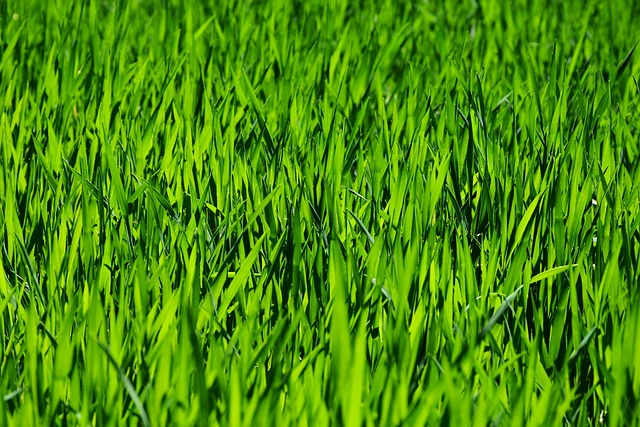Effective Lawn Care and Landscaping are pivotal for maintaining a healthy, resilient lawn that can withstand various environmental conditions and uses throughout the year. Central to this is understanding your local grass type's specific nutritional and soil requirements, including optimal pH levels and nutrient balance. Regular soil testing informs necessary adjustments to support the lawn's growth. Integrated pest management involves a multifaceted approach to manage pests sustainably while preserving the lawn's ecosystem. Consistent, deep watering encourages deep root growth for improved drought resistance, while mowing at the correct height optimizes turf density and health. Aeration and overseeding address soil compaction and introduce new grass varieties to reinforce thin areas. Lawn care professionals utilize their expertise in grass selection, irrigation systems, fertilization, and pest control to ensure lawns remain lush and resistant to stressors. Their design acumen transforms outdoor spaces into functional, sustainable, and visually pleasing environments. By focusing on soil health—its composition, moisture, and aeration—and maintaining the right pH balance, professionals can guarantee a lawn that not only looks attractive but also promotes environmental stewardship. These Lawn Care and Landscaping practices are essential for creating and sustaining a healthy landscape year-round.
navigating the complexities of lawn care and landscaping requires a blend of traditional expertise and modern innovation. This comprehensive guide delves into the essential strategies for optimal turf management, showcasing how understanding soil composition and pH levels, implementing effective irrigation techniques, and following seasonal fertilization plans can lead to vibrant, healthy turf. Additionally, we explore the integration of pest and weed control measures, the importance of aeration and overseeding, and the role of advanced tools and equipment in achieving professional results. Furthermore, the article emphasizes eco-friendly practices that promote sustainable environments, including implementing integrated pest management strategies, xeriscaping, and utilizing organic alternatives for pesticides and herbicides. By combining these approaches, lawn care professionals and landscapers can maintain beautiful, resilient turf while preserving the environment.
- Essential Strategies for Optimal Turf Management in Lawn Care and Landscaping
- – Understanding Soil Composition and pH Levels
Essential Strategies for Optimal Turf Management in Lawn Care and Landscaping

Effective turf management is a cornerstone of high-quality lawn care and landscaping, ensuring lush, healthy grass that withstands various environmental challenges. A fundamental strategy involves understanding the specific type of grass prevalent in your region, as different species have distinct requirements regarding soil pH, nutrient needs, and moisture levels. Regular soil testing allows for precise adjustments to maintain optimal conditions for growth. Another critical aspect is integrated pest management, which combines biological, cultural, physical, and chemical tools to prevent and control pests effectively without over-relying on a single method. This approach not only protects the turf but also promotes ecological balance within the ecosystem of your lawn.
Implementing sound irrigation practices is vital for consistent lawn care and landscaping maintenance. Watering deeply but infrequently encourages deep root growth, leading to a more drought-resistant lawn. Additionally, mowing at the correct height for your grass type can improve turf density and health, as different heights optimize light penetration and nutrient distribution. Aeration and overseeding are also important practices to alleviate soil compaction and introduce new grass varieties to fill in thin areas, ensuring a robust and resilient lawn that can withstand foot traffic and environmental stressors throughout the changing seasons.

Lawn care and landscaping professionals play a pivotal role in maintaining the aesthetic appeal and health of turf areas. Their expertise encompasses a wide array of skills, from selecting the appropriate grass varieties suitable for local soil conditions to implementing effective irrigation systems that conserve water while promoting lush, green lawns. These specialists understand the importance of fertilization and pest control in preventing common issues like brown patches, weeds, and disease, which can detract from a property’s curb appeal and overall value. By staying abreast of the latest turf management techniques, these professionals ensure that lawns are not only visually pleasing but also resilient against environmental stressors and heavy foot traffic. In addition to routine maintenance, landscapers adept in lawn care also excel at designing outdoor spaces that harmonize with the natural environment, creating an inviting and functional area for recreation or relaxation. Their expertise in turf management not only enhances the visual appeal of residential and commercial properties but also contributes to environmental stewardship by promoting sustainable practices within the realm of landscaping.
– Understanding Soil Composition and pH Levels

Maintaining a healthy lawn requires a comprehensive understanding of soil composition and pH levels, which are foundational elements in lawn care and landscaping practices. Soil composition, which encompasses the types and proportions of organic matter, minerals, water, and air, significantly influences plant growth and root development. A well-balanced soil ensures that nutrients are readily available for grass to thrive. Furthermore, monitoring and adjusting pH levels is crucial for optimizing soil fertility; most turfgrass species prefer a slightly acidic to neutral pH range. Adjustments to pH can facilitate the uptake of essential nutrients like nitrogen, phosphorus, and potassium, which are vital for vibrant lawn care and landscaping outcomes. Regular soil testing and pH management are key practices in effective turf management, contributing to a lush and resilient landscape that withstands environmental challenges and enhances the aesthetic appeal of any property.
Effective turf management is a cornerstone of maintaining vibrant, healthy lawns that withstand environmental challenges and aesthetic expectations. This article has outlined critical strategies for optimal turf management in the realm of lawn care and landscaping, emphasizing the importance of soil composition and pH levels as key factors in successful turf maintenance. By implementing these strategies, professionals and enthusiasts alike can achieve and sustain exceptional turf conditions. With a deeper understanding of the science behind soil health and careful application of these principles, anyone can enhance the beauty and durability of their lawns, contributing to the overall appeal and functionality of landscaped spaces.




